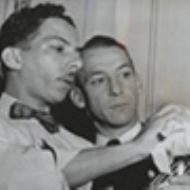Other Officers of the House
“The House of Representatives shall chuse their Speaker and other Officers; and shall have the sole Power of Impeachment.”
— U.S. Constitution, Article I, section 2, clause 5
 /tiles/non-collection/h/hc_rostrum_mace_2006_162_000.xml
Mace, Collection of the U.S. House of Representatives
/tiles/non-collection/h/hc_rostrum_mace_2006_162_000.xml
Mace, Collection of the U.S. House of Representatives About this object The Mace, which symbolizes the authority of House of Representatives, resides near the Speakers rostrum while the House is in session.
The Clerk
When a quorum finally gathered on April 1, 1789, the House first elected its Speaker, Frederick Augustus Conrad Muhlenberg of Pennsylvania, and then its first Clerk, John Beckley of Virginia. While the Clerk’s title, like the Speaker’s, evolved from the British House of Commons, the duties of the office grew as the House wrote its rules. Fundamentally, the Clerk had an organizational function that included receiving the credentials of Members elected to the House, compiling the official list (or roll) of Members, and maintaining the journal of proceedings mandated by the Constitution—duties for which the Clerk’s office is still responsible. As the First Congress (1789–1791) established its rules, the Clerk’s duties multiplied from parliamentary functions like reading bills to ensuring that bills sent to the Senate (engrossed bills) were printed “in a fair round hand.” Clerks also managed the House’s finances and payroll until the Sergeant-at-Arms, and later, the Chief Administrative Officer assumed those duties.
The Doorkeeper
A House of Representatives officer from 1789 to 1995, the Doorkeeper was elected by a resolution at the opening of each Congress. The Office of the Doorkeeper was based on precedent from the Continental Congresses, which controlled entrance to its largely private meetings. Without debate, the First Congress (1789–1791) created the Doorkeeper’s position by resolution on April 2, 1789. The Doorkeeper controlled access to the House Chamber and eventually oversaw the press in the gallery. A total of 34 individuals served in the Doorkeeper position until it was terminated at the opening of the 104th Congress (1995–1997). Many of its duties were transferred to the Sergeant-at-Arms, the Clerk of the House, and the newly created Chief Administrative Officer.
The Sergeant-at-Arms
The House created the Sergeant-at-Arms position on April 14, 1789, and charged it with securing and keeping order within the Chamber, and serving warrants and arresting individuals at the direction of the House and the Speaker. The House also put the Sergeant-at-Arms in charge of the Mace—a symbol borrowed from British practice—to indicate the operating status of the chamber. The duties of the Sergeant-at-Arms have since expanded to include more administrative tasks. In addition to providing security for the chamber and the House side of the Capitol complex, the Sergeant-at-Arms also manages state visits, announces the arrival of the President and other dignitaries during Joint Sessions (a duty previously held by the Doorkeeper), administers parking, and issues identification for staff.
The Chaplain
The election of the Rev. William Linn as Chaplain of the House on May 1, 1789, continued the tradition established by the Continental Congresses of opening each day's proceedings with a prayer. The early House Chaplains alternated duties with their Senate counterparts on a weekly basis. The two conducted Sunday services for the Washington community in the House Chamber every other week. In addition to opening proceedings with prayer, the Chaplain provides pastoral counseling to the House community, coordinates the scheduling of guest chaplains, and arranges memorial services for the House and its staff. In the past, Chaplains have performed marriage and funeral ceremonies for House Members.
The Chief Administrative Officer
The Chief Administrative Officer (CAO) position was created in 1995 to address a host of administrative functions previously performed by the Doorkeeper and the Postmaster. The office deals closely with the Speaker and the Committee on House Administration to assure the smooth operation of House finances as well as technology, human resources, procurement, and services within the House Office Buildings. The predecessor to the CAO was the Director of Non-Legislative and Financial Services. Established by H. Res. 423 in the 102nd Congress (1991–1993), this appointed position was eliminated at the end of the 103rd Congress (1993–1995).
The Postmaster
An elected officer for nearly 160 years (24th through the 102nd Congresses), the Postmaster managed mail operations in the House. Initially, workers in the Doorkeeper’s office were paid additional compensation to perform mail duties, but a December 13, 1832, resolution made the Postmaster a distinct and permanent House employee. In 1834, William J. McCormick, a Doorkeeper’s employee, was named the first House Postmaster. Four years later, the House adopted a rule that charged the Postmaster with superintending the post office in the Capitol and overseeing the delivery of mail to Members and Officers. The House Reform Resolution of 1992 (H. Res. 423, April 9, 1992), abolished the Office of the Postmaster and reassigned mail handling procedures for the House of Representatives to other House Officers and private entities. A total of 21 Postmasters served in the House.
For Further Reading
Brudnick, Ida A. “Support Offices in the House of Representatives: Roles and Authorities.” 18 May 2011. Report RS33220. Congressional Research Service. Washington, D.C.: Library of Congress.
Cannon’s Precedents of the House of Representatives of the United States. Six volumes. Washington, D.C.: Government Printing Office, 1935–1941.
Constitution, Jefferson’s Manual and Rules of the House of Representatives. Washington, D.C.: Government Printing Office, 1896 to present.
Deschler’s Precedents of the House of Representatives of the United States. Nine volumes. Washington, D.C.: Government Printing Office, 1976–1977.
Hinds’ Precedents of the House of Representatives of the United States. Eight volumes. Washington, D.C.: Government Printing Office, 1907–1908.
Sullivan, John. House Practice: A Guide to the Rules, Precedents, and Procedures of the House. Washington: Government Printing Office, 2011.











